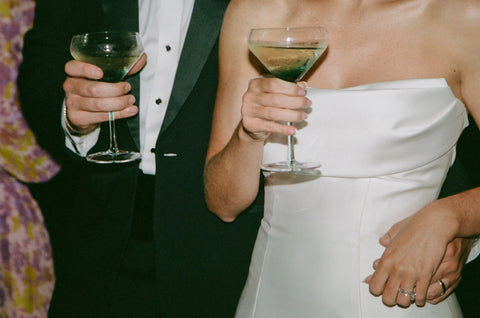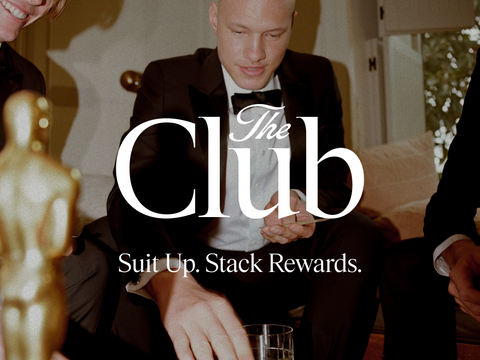Without suit accessories, a suit is just a jacket and pants—no more, no less. Coordinating accessories like your pocket square and tie may seem tedious, but it's the primary way to express your personality and style, and set yourself apart in an otherwise simple, classic suit.
In this guide, we'll cover the major suit accessories categories and show you the basics of making any suit your suit.
Shop Suit Accessories →
Table of Contents
Suit Accessories: Neckwear
The tie is the most ubiquitous of all suit accessories—if you've worn a suit, you've almost certainly worn a tie. Bonus points if you tied it yourself; triple if it was a bow tie.

Bow ties are a little more formal than neckties. After all, they're the standard neckwear for a formal tuxedo. But when you're wearing a suit, you can really go either way with neckwear.
It's also safe to assume you're more familiar with a necktie (most of us are), but that can actually be a solid argument for testing the bow tie waters. They're less common, so wearing a bow tie can help you stand out. Choosing between a bow tie and necktie is actually easy—go with your gut, and wear what makes you feel comfortable and confident. (If knot knowledge is holding you back, learn how to tie a bow tie here.)

Once you've decided, consider the details, like pattern and fabric. The more formal the event the more subtle you'll want the pattern to be, but if your default is a solid tie, try something new. As for fabric (or material), base your choice on the season. For a summer event, go with a lighter texture fabric like cotton, linen, or seersucker.

For winter, a heavier velvet or wool makes sense. Silk and satin are fair game year-round, and are a safe option for a more formal event.
Suit Accessories: Pocket Squares
To some, the pocket square is an unnecessary extravagance. To others, a hanky for runny boogies. Both of these opinions is incorrect, and further, why did we ask a toddler for their opinion? Everyone is fired.

While a pocket square looks the part of a fancy handkerchief, it is not designed for nasal utility. It's a style choice, and one you should wear one as often as possible. A suit and tie with no pocket square tells the world you're just going through the motions—you had to wear a suit, so here it is, move along. It might seem optional, but why do you think the outer breast pocket of a suit jacket exists? Do not say snacks.
However, choosing a pocket square isn't as simple as matching it with your tie. Instead, try to coordinate the the two. Patterns in differing scales (think a polka dot pattern with pin dot), a pattern and a solid in the same color family, or complementary colors are all pretty easy to put together.

Suit Accessories: Cufflinks & Tie Clips
Cufflinks and tie clips: the OG men's suit jewelry. Men's fashion has changed a lot (and continues to do so), and bold self-expression with suit accessories is trending and encouraged. If you're not ready to go big, you can still make some key outfit upgrades in simple, low-key ways (like wearing cufflinks).

Step one: Confirm the shirt you're planning to wear will accept cufflinks.
The typical dress shirt is designed with barrel cuffs. Not all have the openings needed for cufflinks—you're looking for two buttonholes instead of the typical "one button, one buttonhole" configuration. Some shirts are made to be worn either way (like ours). A shirt with french cuffs will almost always require cufflinks, to which we say "oui, please."

Step 2: Choose your style.
There are as many cufflink designs as there are suit styles, from very plain to meticulously detailed, modern to ridiculous. The great thing about cufflinks is that no matter the style, they won't define your look—they're merely accents. Don't hesitate, do you my good dude.

Tie clips are pretty similar, though they're a bit more visible than cufflinks. For that reason, we gravitate toward a minimal look, especially for events on the formal end of the spectrum.

When it comes to the metal color, we recommend coordinating your gold cufflinks with a gold tie clip, silver accessories with silver cufflinks, brass with brass, etc. There are no cufflink cops to bust you if you mix metals (that we know of), but it's one less thing to overthink.
Suit Accessories: Shoes (& Socks)
Whether you go straightforward or fashion-forward, your shoes have a big impact on your outfit. The classic options are derbys or oxford lace-ups—both great for formal and casual events alike. For a casual look, you should also consider a loafer or slipper.

What about boots? They require some finesse, but with some confidence and know-how, they can look pretty great. Still, most of us will find plenty of options in a lace-up or loafer. Sneakers are incredibly hit or miss, so proceed with caution (and fashionable inspo).

If you're traditional, socks won't require much thought—you're probably grabbing a calf-high pair in black, grey, or navy, perhaps with a pinstripe or subtle pattern. These go-to's cover virtually every situation. Novelty socks are their own beast, and we can only suggest that whatever you're thinking about wearing, reduce the intensity by 20%. If you've got warm weather to work with, think about going sockless—practically a requirement with loafers, and a good summer look with any dress shoe.
Suit Accessories: Belts & Suspenders
While most of the suit accessories above are mandatory for a complete outfit (or very close to it), wearing a belt or suspenders with your suit is not. In an ideal world, you'd probably have the suit pant waist tailored to fit properly without support. But that's in an ideal world. The fact is our weights fluctuate, a lot of us rent a suit rather than purchasing one that we can alter, and yet we still need our pants to stay up and on.

The obvious solution is a belt, and you'll want to coordinate your belt's color with your shoes. If you don't have a perfect match, just get the colors in the same ballpark, or at most, the same color family. Alternatively, you could wear suspenders, which tend to give off a folksy, rustic vibe. They accomplish the same thing, with the added benefit of staying hidden behind your suit jacket.

Fit > Accessories
Suit accessories are obviously an important part of any formal outfit, which is why we put so much effort into designing unique options and making them available for everyone. But accessories alone can't make up for a bad suit, or a bad fit.
If your pants are three inches too long, those shoes you love aren't going to look great (if you can even see them under all that fabric). Any tie's going to look sloppy if your dress shirt is too big. That's why we don't stop with a great design—we make sure the suit fits, too. The best part? Getting the right fit is simple. Just answer a few questions to find your sizes now.









